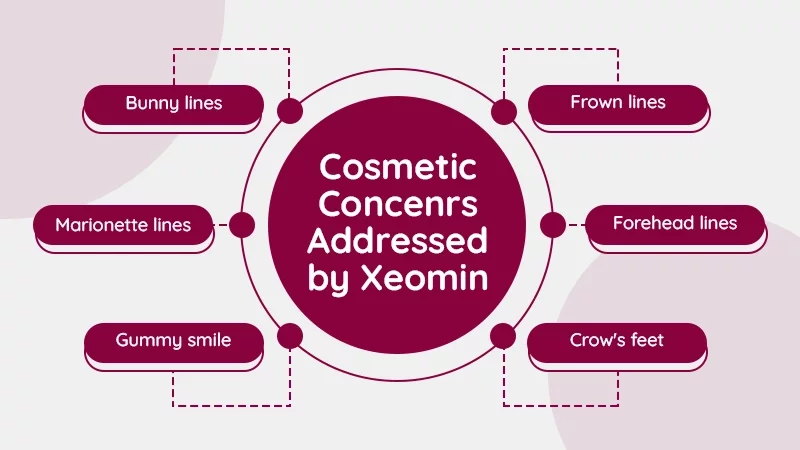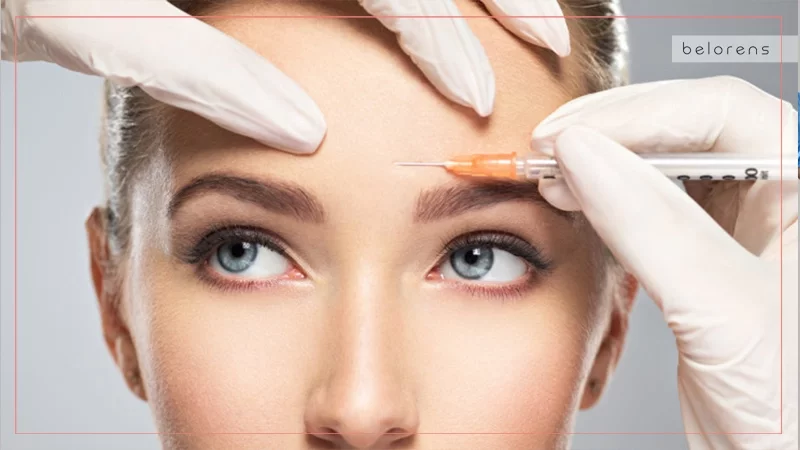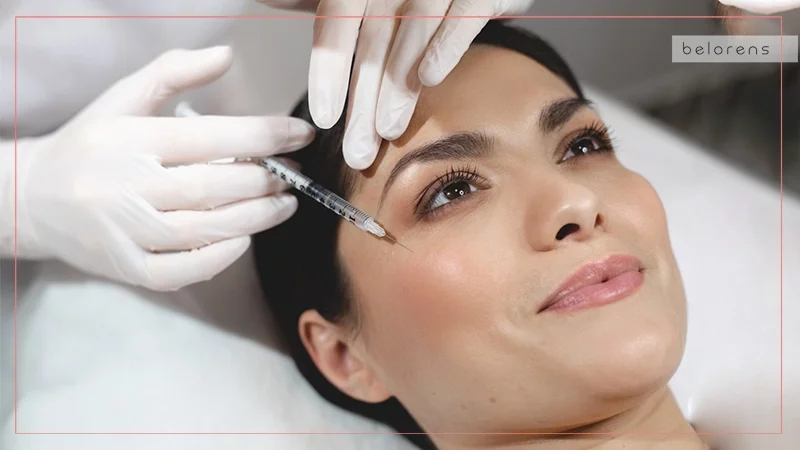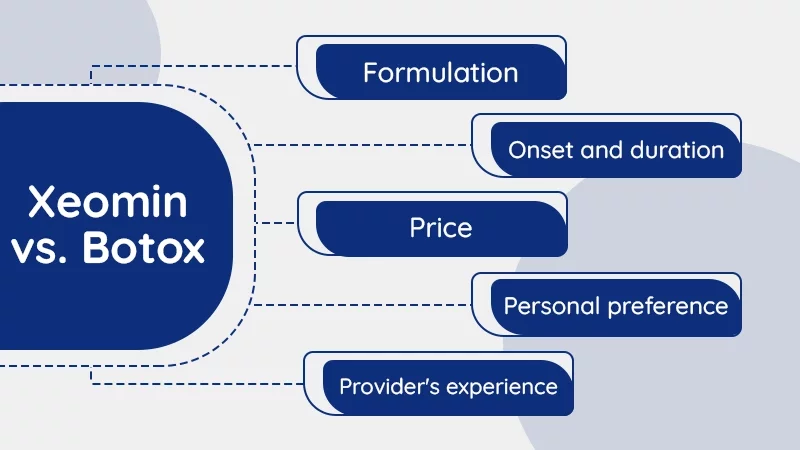Published on 12 June 2024
Xeomin Injection: Everything You Need to Know
- ByMedical Content Team
- Medically Reviewed byDr. Sabine Kulhanek
Fact checked

- What is Xeomin?
- What are the cosmetic uses of Xeomin?
- Am I a suitable candidate?
- How is Xeomin injection performed?
- How to prepare
- What to expect after the injection
- Risks and side effects of Xeomin
- How much does Xeomin cost?
- How many units of Xeomin do I need?
- Xeomin vs. Botox: which is right for me?
- FAQs about Xeomin injection
While Botox often steals the limelight, Xeomin boasts its own arsenal of remarkable qualities that make it a standout contender in the realm of cosmetic enhancements. Xeomin is the only botulinum toxin type A formulation that does not contain any additives. It means zero accessory proteins! This unique feature reduces the risk of antibody formation, potentially extending its efficacy and longevity compared to its counterparts.
But that's not all – Xeomin's purity doesn't just stop there. Its formulation is meticulously crafted through a state-of-the-art manufacturing process, ensuring consistent potency and reliability with each treatment. And here's the kicker – studies suggest that Xeomin may have a quicker onset of action, meaning you could be flaunting smoother, more youthful skin in no time. So, buckle up as we delve deeper into the world of Xeomin, uncovering its secrets, and exploring why it might just be the secret weapon your skincare routine has been missing.
What is Xeomin?
Xeomin is a prescription medication that contains incobotulinumtoxinA, a type of botulinum toxin type A. It is similar to Botox and Dysport and is used for cosmetic purposes, including temporarily improving the appearance of moderate to severe frown lines between the eyebrows (glabellar lines) in adults. Xeomin works by blocking nerve signals in the muscles, reducing muscle activity, and smoothing out wrinkles in the treated area. It is administered by injection and should only be performed by qualified healthcare professionals.
What are the cosmetic uses of Xeomin?
Xeomin is primarily used for cosmetic purposes to address facial wrinkles and lines. Some common cosmetic uses of the medicine include:

- Frown lines: Xeomin is commonly used to improve the appearance of moderate to severe frown lines between the eyebrows (glabellar lines), also known as "11 lines" or "angry lines."
- Forehead lines: Xeomin can help reduce the appearance of horizontal forehead lines that are caused by repetitive muscle movements and expressions.
- Crow's feet: Xeomin injections can be used to soften and smooth out the fine lines and wrinkles around the outer corners of the eyes, known as crow's feet.
- Bunny lines: Xeomin can also be used to address bunny lines, which are the wrinkles that form on the nose when smiling or scrunching up the face.
- Marionette lines: Xeomin can be used to soften the appearance of marionette lines, which are the lines that run from the corners of the mouth downward.
- Gummy smile: Xeomin injections may help reduce excessive gum exposure when smiling, known as a gummy smile, by relaxing the muscles responsible for pulling the upper lip too high.
These cosmetic uses of Xeomin aim to temporarily relax specific facial muscles, leading to a smoother, more youthful appearance by reducing the visibility of wrinkles and fine lines. It is essential to consult with a qualified healthcare professional or cosmetic provider to determine the most suitable treatment plan based on individual aesthetic goals and concerns.
Am I a suitable candidate?
Determining whether you are a suitable candidate for Xeomin injections depends on various factors, including your medical history, aesthetic goals, skin condition, and expectations. Generally, suitable candidates for Xeomin injections are adults who are looking to address specific facial wrinkles and lines, such as frown lines, forehead lines, crow's feet, or other targeted areas. You may be a suitable candidate for Xeomin injections if:
- You are in good overall health with no contraindications to receiving botulinum toxin injections.
- You have realistic expectations about the potential results of the treatment.
- You are bothered by moderate to severe facial wrinkles or lines that Xeomin can help improve.
- You have discussed your aesthetic goals and concerns with a qualified healthcare professional or cosmetic provider.
Xeomin may not be suitable for everyone, and there are certain contraindications and considerations to keep in mind. Individuals who fall into the following categories may not be ideal candidates for Xeomin injections:
- If you are allergic to any of the ingredients in Xeomin, including botulinum toxin type A or albumin, you should not use this medicine.
- Individuals with pre-existing neuromuscular disorders such as myasthenia gravis or Lambert-Eaton syndrome may be at an increased risk of experiencing adverse effects from Xeomin injections.
- It is generally recommended to avoid Xeomin injections during pregnancy and breastfeeding due to limited data on the effects of botulinum toxin on the fetus or infant.
- If there is an active infection at the planned injection site, it is advisable to postpone Xeomin treatment until the infection has resolved to prevent complications.
- Some medications, such as certain antibiotics or muscle relaxants, may interact with Xeomin and increase the risk of side effects. Inform your healthcare provider about all medications you are taking before undergoing treatment.
- Individuals who have had a previous adverse reaction to botulinum toxin injections or a history of side effects from similar treatments should exercise caution or avoid Xeomin injections.
- If you have significant weakness or atrophy in the facial muscles due to underlying conditions or previous treatments, Xeomin injections may not be suitable as they could exacerbate muscle weakness.
It is important to schedule a consultation with a healthcare professional who is experienced in administering Xeomin injections to assess your candidacy accurately. During the consultation, the provider will evaluate your facial anatomy, discuss your medical history and expectations, and create a personalized treatment plan tailored to your specific needs and goals.
It is crucial to disclose any medical conditions, allergies, medications, or previous cosmetic procedures during the consultation to ensure your safety and the effectiveness of the treatment. Consulting with a qualified healthcare professional will help determine if Xeomin injections are suitable for you and address any concerns you may have regarding the procedure.
How is Xeomin injection performed?

Xeomin injections are typically performed in a medical office or a clinical setting by a qualified healthcare professional, such as a dermatologist or a plastic surgeon. The procedure for administering Xeomin injections is as follows:
- Consultation: Before the injection, you will have a consultation with the healthcare provider to discuss your aesthetic goals, medical history, any allergies, medications you are taking, and expectations from the treatment.
- Preparation: The healthcare provider will cleanse the treatment area and may apply a topical numbing cream to minimize discomfort during the injection, although Xeomin injections are generally well-tolerated without anesthesia.
- Injection: Using a fine needle, the healthcare provider will inject Xeomin directly into the targeted facial muscles responsible for causing wrinkles or lines. The number of injections and the amount of Xeomin used will depend on the treatment area and desired results.
- Post-injection care: After the injections, you may experience some mild redness, swelling, or bruising at the injection sites, which is normal and usually resolves within a few hours to days. Avoid rubbing or massaging the treated area to prevent the spread of the toxin.
- Follow-up: The healthcare provider may schedule a follow-up appointment to assess the results of the Xeomin injections and make any necessary adjustments for optimal outcomes.
It is important to follow any post-injection care instructions provided by the healthcare provider and avoid activities that could increase swelling or bruising in the treated area. Results from Xeomin injections typically become noticeable within a few days to a week after the treatment and can last for several months before needing a touch-up or repeat injections to maintain the desired effects.
How to prepare
To prepare for Xeomin injections, follow these steps:
- Consultation: Schedule a consultation with a qualified healthcare provider to discuss your goals, medical history, and suitability for Xeomin injections.
- Medical history: Provide your complete medical history, including any allergies, medical conditions, medications, and previous cosmetic procedures.
- Avoid blood thinners: To reduce the risk of bruising, avoid blood-thinning medications like aspirin, ibuprofen, and supplements like fish oil for a few days before the procedure.
- Stay hydrated: Drink plenty of water before the treatment to keep your skin hydrated, which can improve the injection process.
- Sun protection: Limit sun exposure and tanning bed use before the procedure to prevent skin irritation.
- Communicate expectations: Clearly communicate your aesthetic goals and expectations with the healthcare provider to ensure they align with what Xeomin can achieve.
- Follow provider's instructions: Adhere to any specific pre-injection guidelines provided by the healthcare provider, such as avoiding certain skincare products or makeup on the day of the procedure.
- Arrive prepared: Arrive on time with a clean face, free of makeup or skincare products, to facilitate the assessment and treatment process.
By following these preparation steps and collaborating closely with your healthcare provider, you can help ensure a successful and satisfactory experience with Xeomin injections. It is essential to follow the provider's recommendations and address any concerns or questions you may have before the procedure to feel prepared and informed.
What to expect after the injection

After receiving Xeomin injections, you can expect the following:
- Immediate side effects: You may experience some redness, swelling, or minor bruising at the injection sites, but these side effects are typically mild and temporary.
- Discomfort: Some individuals may feel slight discomfort or a pinching sensation during the injections, but this usually subsides quickly.
- Results: It may take a few days to a week to see the full effects of Xeomin as the toxin gradually relaxes the targeted facial muscles. Results typically last for several months.
- Avoidance of certain activities: It is recommended to avoid rubbing or massaging the treated area and to refrain from strenuous exercise, excessive sun exposure, or heat exposure immediately after the injections.
- Follow-up: Your healthcare provider may schedule a follow-up appointment to assess the results and determine if any touch-ups are needed for optimal outcomes.
- Normal activities: In most cases, you can resume normal activities immediately after the injections, but it is best to follow any specific post-injection care instructions provided by your healthcare provider.
- Long-term care: To maintain the results of Xeomin injections, consider a consistent skincare routine, sun protection, and healthy lifestyle habits to support skin health and longevity of the treatment effects.
If you have any concerns or experience unusual symptoms after the injections, contact your healthcare provider for guidance.
Risks and side effects of Xeomin
Xeomin injections are generally safe when administered by qualified healthcare professionals. However, like any medical procedure, there are potential risks and side effects associated with this procedure. Some common risks and side effects of Xeomin injections include:
- Injection site reactions: Redness, swelling, bruising, or tenderness at the injection site are common and usually temporary.
- Headache: Some individuals may experience mild headaches after receiving Xeomin injections, which typically resolve on their own.
- Eyelid drooping: In rare cases, Xeomin injections near the eyes can cause temporary eyelid drooping (ptosis), which usually resolves within a few weeks.
- Muscle weakness: Over-treatment or improper injection technique can lead to unintended muscle weakness in nearby areas, resulting in asymmetry or other facial issues.
- Allergic reactions: While rare, allergic reactions to Xeomin can occur, leading to symptoms such as itching, rash, or difficulty breathing. Seek immediate medical attention if you experience signs of an allergic reaction.
- Spread of toxin: If Xeomin spreads beyond the intended treatment area, it can cause muscle weakness, swallowing difficulties, or breathing problems. This is rare but requires prompt medical attention.
- Infection: As with any injection, there is a risk of infection at the injection site. Proper sterile techniques can help minimize this risk.
- Unsatisfactory results: Occasionally, individuals may not achieve the desired results from Xeomin injections, necessitating further treatments or adjustments.
It is crucial to discuss the potential risks and side effects of Xeomin injections with your healthcare provider before undergoing the procedure. By choosing a qualified and experienced provider, following pre- and post-injection instructions, and communicating openly about your expectations, you can minimize the risks and enhance the safety and effectiveness of Xeomin injections.
How much does Xeomin cost?

The cost of Xeomin injections can vary depending on several factors, including the geographic location, the healthcare provider's expertise, the number of units required for treatment, and any additional fees associated with the procedure. On average, the cost of Xeomin injections ranges from $200 to $600 per treatment session.
Keep in mind that most providers charge for Xeomin injections based on the number of units used during the treatment. The number of units needed can vary depending on the treatment area, the severity of wrinkles, and individual factors. Providers may also offer package deals or discounts for multiple treatment sessions.
It is essential to consult with a qualified healthcare provider for an individualized assessment and to obtain an accurate cost estimate for Xeomin injections based on your specific needs and treatment goals. Additionally, inquire about any additional fees, such as consultation fees or follow-up appointments, to have a comprehensive understanding of the total cost involved in the Xeomin treatment process.
How many units of Xeomin do I need?
The number of units of Xeomin needed for treatment varies depending on several factors, including the area being treated, the severity of wrinkles or muscle activity, and individual response to the neurotoxin. Typically, healthcare providers determine the appropriate dosage based on your specific facial anatomy and treatment goals. As a general guideline, here are some common ranges of units used for different treatment areas with Xeomin:
- Glabellar lines (frown lines): Approximately 20-30 units
- Forehead lines: Around 10-20 units
- Crow's feet: Around 5-15 units per side
- Bunny lines: Typically 5-10 units
- Marionette lines: About 2-6 units per side
It is crucial to have a consultation with a qualified healthcare provider who can assess your specific concerns, evaluate your facial muscles, and recommend the appropriate number of units needed for effective treatment.
Xeomin vs. Botox: which is right for me?
Both Xeomin and Botox are neurotoxin injectables used to temporarily improve the appearance of wrinkles and fine lines by relaxing facial muscles. While they are similar in many ways, there are some differences that may influence your choice between the two. Here are some factors to consider when deciding between Xeomin and Botox:

- Formulation: Botox and Xeomin are both derived from botulinum toxin type A, but they have different formulations. Xeomin contains only the active ingredient, while Botox includes accessory proteins. Some individuals prefer Xeomin due to its "purer" formulation, which may reduce the risk of developing antibodies against the neurotoxin over time.
- Onset and duration: Botox typically has a quicker onset of action, with results becoming noticeable within a few days, whereas Xeomin may take a bit longer to show full effects. The duration of results is similar for both, lasting around 3-6 months before a repeat treatment is needed.
- Price: In general, the pricing for Botox and Xeomin is often similar, with neither consistently being more expensive than the other.
- Personal preference: Some individuals may have a preference for one product over the other based on their own experiences, results, or recommendations from their healthcare provider.
- Provider's experience: The expertise and experience of your healthcare provider with each product may also influence your decision. Ensure you choose a qualified and skilled injector for optimal results.
Ultimately, the choice between Xeomin and Botox depends on your individual preferences, goals, and consultation with a healthcare provider. They can assess your facial anatomy, discuss your concerns, and recommend the most suitable option based on your unique needs. Consider scheduling consultations with providers experienced in both Xeomin and Botox to determine which product aligns best with your expectations and desired outcomes.
Also Read: Injectable Toxins: Compare Botox, Dysport, and Xeomin
FAQs about Xeomin injection
Is Xeomin FDA-approved?
Xeomin is approved by the FDA for the temporary improvement of moderate to severe glabellar lines (frown lines) in adults. However, using this medicine for off-label purposes, meaning uses not approved by the FDA (including other types of facial lines and wrinkles) is legal and common in medical practice. Healthcare providers may legally prescribe medications, including Xeomin, for off-label uses based on their clinical judgment and expertise.
How long does it take to see the results of Xeomin?
Full effects of Xeomin are usually seen within 7 days post-injection, with gradual improvement in the appearance of wrinkles and lines.
How long do the results of Xeomin last?
Results of Xeomin typically last around 3-6 months before a repeat treatment is needed.




